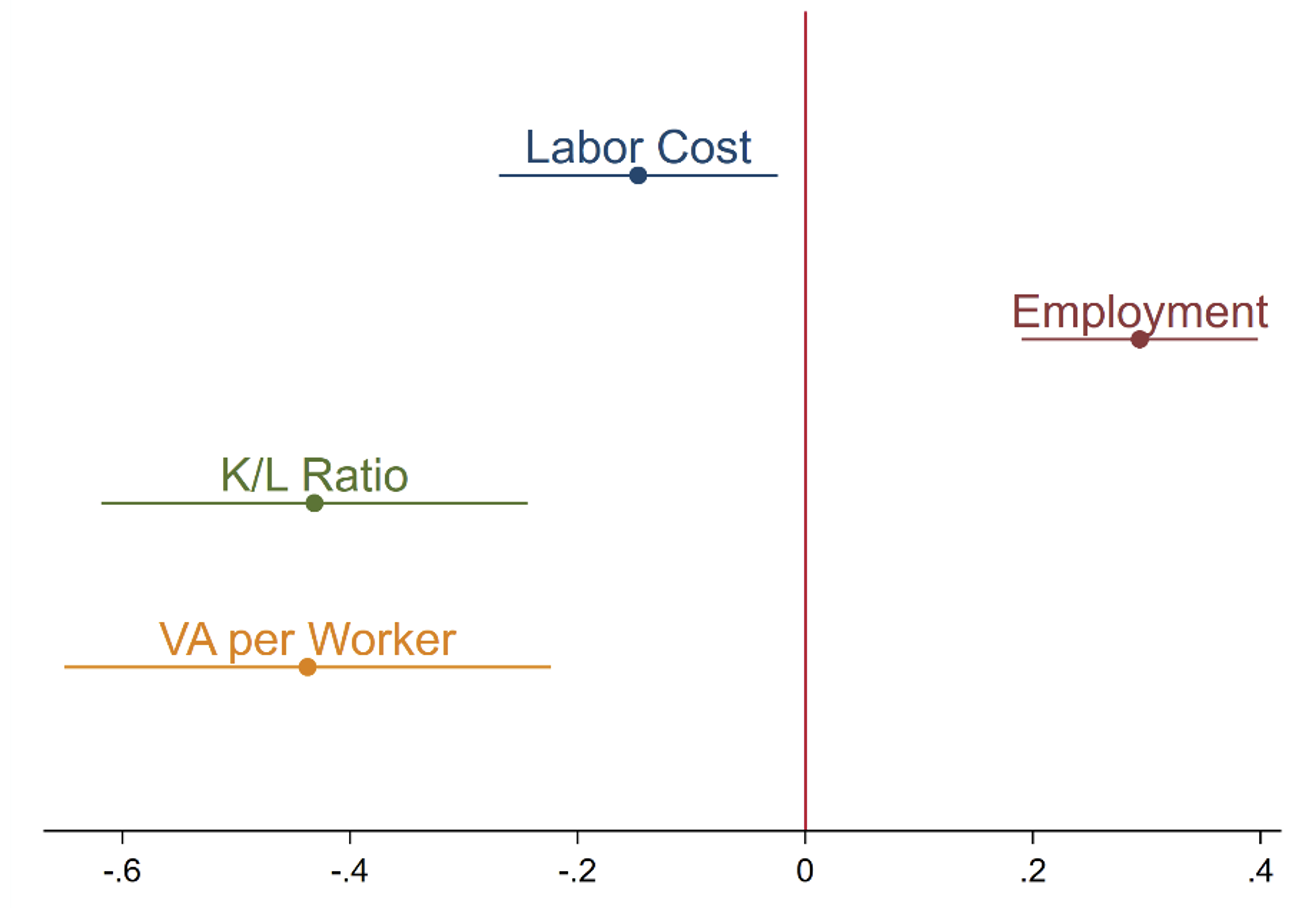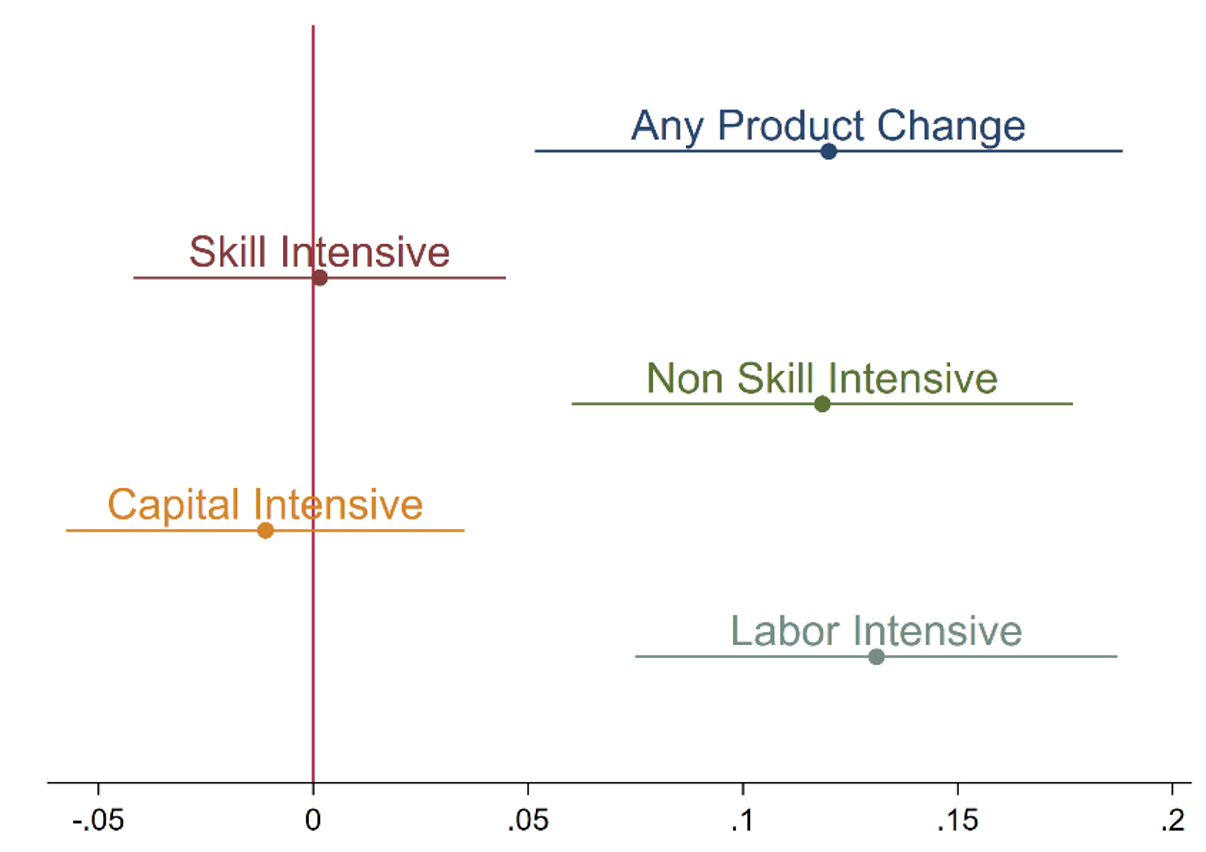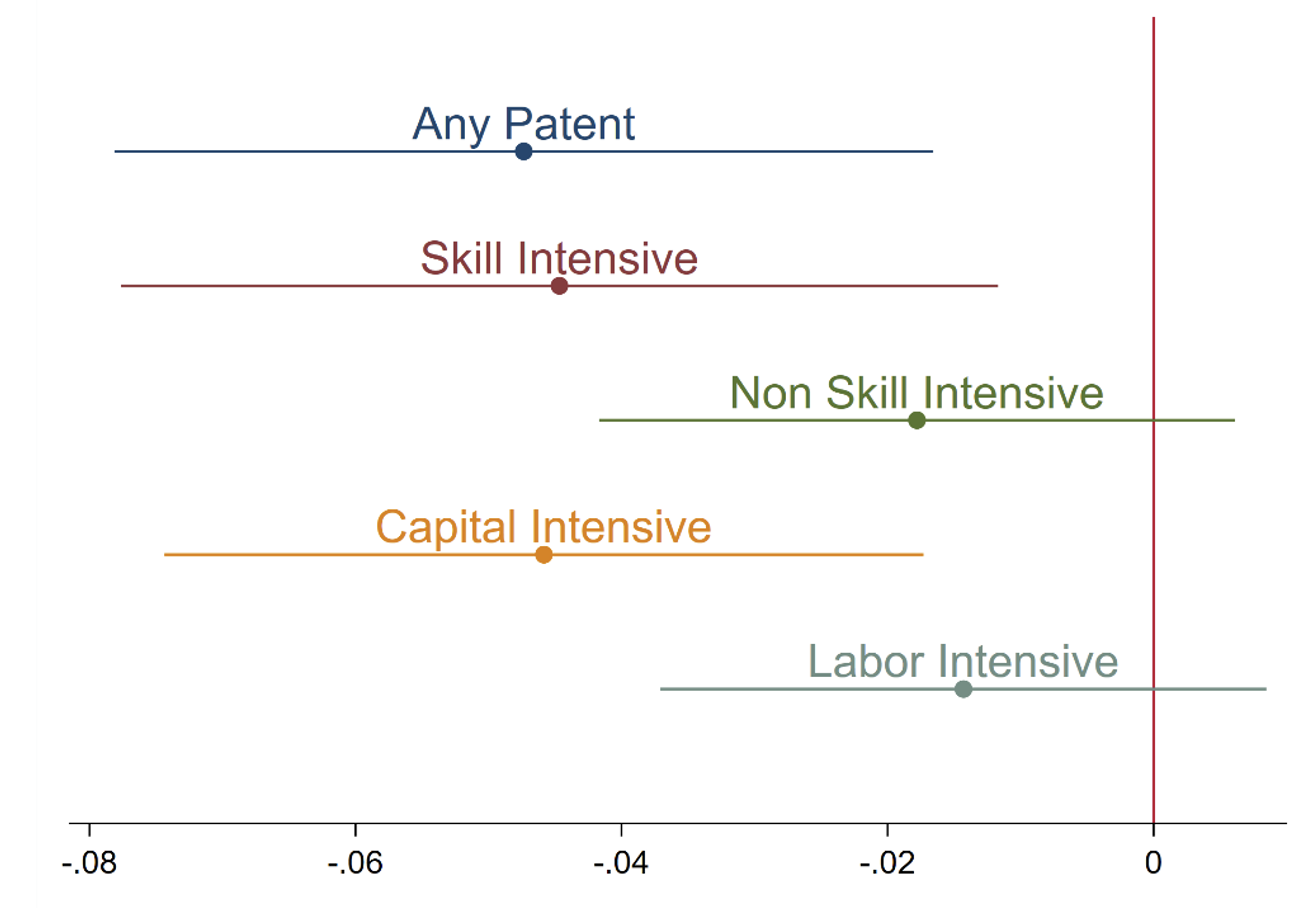
In response to migration from rural areas, manufacturing production becomes more labour intensive due to a change in technology and product varieties
Firms in developing countries typically have lower productivity per worker (Hall and Jones 1999) and this pattern can be explained by a number of factors. These include imperfect access to capital (Banerjee and Duflo 2014), inputs (Boehm and Oberfield 2020), technology (Howitt 2000), international markets (Verhoogen 2008), or poor management practices (Bloom et al. 2013). Another potential factor may be the abundance of migrant labour as the process of economic development induces large movements of rural workers from agriculture to manufacturing (Lewis 1954). This could potentially reduce firms’ incentives to adopt productivity-enhancing technologies (Lewis 2011). Despite its relevance, empirical evidence on the role of rural-urban migration in shaping urban production in developing countries is scarce.
In Imbert et al. (2022), published in the June issue of the American Economic Review, we provide some of the first evidence on the causal impact of labour inflows on firms in developing countries. Identifying the causal effect of immigration is challenging as migrants often choose destinations where wages are high, and firms are growing. Our methodology proceeds in two steps. First, we isolate exogenous agricultural income shocks due to unexpected shocks in international prices for agricultural commodities and variation in cropping patterns across prefectures of origin. We then combine these predictors of rural emigration (the ‘shifts’) with historical migration patterns between prefectures (the ‘shares’). The resulting shift-share instrument strongly predicts migrant inflows to cities and exhibits substantial variation across prefectures of destination.
Rural migrant labour supply decreases labour costs and firm production becomes more labour intensive
Armed with this exogenous variation in migration inflows to Chinese cities, we estimate the causal effect of immigration on firms, using longitudinal micro data on all large Chinese manufacturing firms between 2000 and 2006.1 We find that after an influx of migrants, labour costs go down while production becomes much more labour intensive as capital does not adjust to changes in employment, and value added per worker sharply decreases (see Figure 1). The effects are large in economic terms – a ten percentage point increase in the migrant share at destination causes a 1.5% decrease in compensation per employee and a 4.3% decrease in the capital-to-labour ratio.
Figure 1 Effect of immigration on production patterns in manufacturing firms

Note: Each dot is the coefficient from a regression of the change in (log) outcome variable on the immigration rate. The whiskers represent 95% confidence intervals. See the interpretation in the text.
Although our main results focus on firms observed every year between 2000 and 2006, the composition of the manufacturing sector is in constant evolution during the period, and many firms enter and exit the sample. When we consider all firms present in the sample at any point in time, the shift toward labour-intensive production and the decline in productivity following a migration shock are even more pronounced. This suggests that following a migration shock, labour-intensive, low-productivity firms are less likely to die and more likely to grow.
Firms adopt low-skilled labour-intensive product varieties and are less likely to create capital-intensive technologies
Changes in input mix may reflect changes in the type of manufacturing goods, or changes in the technology used to produce a similar output as in Beaudry and Green (2003). We look at adjustments along both margins. To better characterise the impact of labour inflows on the production process, we first exploit the textual descriptions of products given by manufacturing establishments. More specifically, we use a natural language processing (NLP) algorithm to assign each firm’s product to a product code in the international classification (HS-6).2 We then characterise the direction of a change in output mix by looking at factor use within product classes. We find that a ten percentage point increase in the migration rate increases the probability to change products by 2%, toward products that are labour intensive and with low human capital intensity (see Figure 2).
Figure 2 Effect of rural migrant labour supply on product choice by manufacturing firms

Note: Each dot is the coefficient from a regression of the change in (log) outcome variable on the immigration rate. The whiskers represent 95% confidence intervals. See the interpretation in the text.
Using a match between manufacturing firms and patent applications (He et al. 2018), we also find evidence of a marked decrease in patenting where a ten percentage point increase in the migration rate decreases the probability of patent submission by 10%. Importantly, the decline in patenting is concentrated in categories linked to fundamental innovation and new production methods, and in patent classes that are capital and skill intensive (see Figure 3).
Figure 3 Effect of rural migrant labour supply on patenting by manufacturing firms

Note: Each dot is the coefficient from a regression of the change in (log) outcome variables on the immigration rate. The whiskers represent 95% confidence intervals. See the interpretation in the text.
Finally, we explore whether changes in technology and input mix are systematically related to endogenous product choice. We find that firms that experience an increase in labour supply through migration change their input mix irrespective of a possible change in product. By contrast, the decline in patenting only occurs among firms that also adjust their product in response to migration. These results suggest that there is directed technological change for a given output mix as in Beaudry and Green (2003). However, the product choice is also a margin of adjustment as innovative firms which would have pushed the technological frontier through capital-augmenting innovation, now prefer to shift along the frontier and adopt more labour-intensive product varieties.
Take-aways
Our analysis shows that migration from rural areas decreases labour costs and increases employment, and that manufacturing production becomes more labour-intensive as capital does not adjust. We are also able to document the reorganisation of production with unique data on product choice and patent applications. Our results show that the abundance of rural migrant labour triggers labour-oriented technological change and the adoption of labour-intensive product varieties among manufacturing firms. This mechanism is likely at play in other developing countries that experience structural transformation. Our results also speak to China’s sharp trend reversal over the last decade with lower rural-urban migration and faster automation in manufacturing (Cheng et al. 2019).
References
Banerjee, A. V and E Duflo (2014), “Do Firms Want to Borrow More? Testing Credit Constraints Using a Directed Lending Program”, Review of Economic Studies 81(2): 572–607.
Beaudry, P and D. A Green (2003), “Wages and employment in the United States and Germany: What explains the differences?”, American Economic Review 93(3): 573–602.
Bloom, N, B Eifert, D McKenzie, A Mahajan, and J Roberts (2013) “Does management matter: evidence from India”, The Quarterly Journal of Economics 128(1): 1-51.
Boehm, J and E Oberfield (2020), “Misallocation in the Market for Inputs: Enforcement and the Organization of Production”, The Quarterly Journal of Economics 135(4): 2007–2058.
Cheng, H, R Jia, D Li, and H Li (2019), “The Rise of Robots in China”, Journal of Economic Perspectives 33(2): 71-88.
Hall, R. E and C. I Jones (1999), “Why do Some Countries Produce So Much More Output Per Worker than Others?” The Quarterly Journal of Economics, 114(1): 83–116.
He, Z. L, T. W Tong, Y Zhang, and W He (2018), “A database linking Chinese patents to China’s census firms”, Scientific data 5(1): 1-16
Howitt, P (2000), “Endogenous Growth and Cross-Country Income Differences.” American Economic Review, 90(4): 829–846.
Imbert, C, M Seror, Y Zhang, and Y Zylberberg (2022), “Migrants and Firms: Evidence from China”, American Economic Review 112 (6): 1885-1914.
Lewis, A (1954), “Economic Development with Unlimited Supplies of Labour”, The Manchester School 22(2): 139–191.
Lewis, E (2011), “Immigration, Skill Mix, and Capital Skill Complementarity”, The Quarterly Journal of Economics 126(2): 1029–1069.
Verhoogen, E. A (2008), “Trade, Quality Upgrading, and Wage Inequality in the Mexican Manufacturing Sector”, The Quarterly Journal of Economics 123(2): 489–530.
Endnotes
1 The sample includes all firms with sales above RMB 5 million (approximately $600,000).
2 This match and the code used to produce it are available in the replication package of Imbert et al. (2022).




